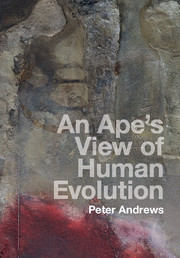Book contents
- Frontmatter
- Contents
- Preface
- 1 How can we recognize common ancestors?
- Part I Apes: their morphology and behaviour
- PART II Environments and palaeoenvironments
- Part III Review of fossil apes
- Part IV Last common ancestor
- 16 Putting together the evidence
- 17 An ape's view of human evolution
- References and further reading
- Index
- References
16 - Putting together the evidence
from Part IV - Last common ancestor
Published online by Cambridge University Press: 05 January 2016
- Frontmatter
- Contents
- Preface
- 1 How can we recognize common ancestors?
- Part I Apes: their morphology and behaviour
- PART II Environments and palaeoenvironments
- Part III Review of fossil apes
- Part IV Last common ancestor
- 16 Putting together the evidence
- 17 An ape's view of human evolution
- References and further reading
- Index
- References
Summary
The evidence from fossil apes
We have seen in Chapters 7 to 14 that fossil apes span the period from before 20 million years ago in the early Miocene to about 8 million years ago in the late Miocene. In the early Miocene, apes were locally abundant but only known from East Africa. They were arboreal monkey-like primates, quadrupedal (moving on all four legs) with pronograde posture (the body parallel with the ground). One possible exception to this is Morotopithecus, which appears to have had incipient stages of upright posture. Their skulls were lightly built, with narrow noses, broad orbits and a muzzle-like lower face with moderate lower and mid-face prognathism. They had relatively narrow incisors, projecting canines, variable canine/premolar honing, and relatively small molars and premolars with variable enamel thickness. They had narrow chests, limited mobility of the hind legs but greater mobility at their shoulders and elbows, and their hands and feet were adapted for gripping but not for load bearing. Their thumbs were not reduced in length as in great apes, but were slightly shorter relative to the thumb in human hands. The thumb in the Proconsul hand (Chapter 7) had a hinge joint rather than the rotatory joint present in the human hand, but it is likely that they had a precision grip, and with the greater thumb length they probably had greater manipulative abilities than chimpanzees today. The species ranged in size from 10 to 80{ts}kg, the weight of male chimpanzees. They had relatively large brains for their size, and they were associated with tropical forest and deciduous woodland environments, the latter with single tree canopies growing in seasonal (wet−dry) climates. They had primarily arboreal adaptations, but the body size of the larger species would have necessitated some degree of terrestrial locomotion in their woodland habitats, particularly if any distance had to be covered from one part of the woodland to another, as the small branch contact between woodland trees limits movement from one tree to another for all but small mammals. For the most part they had soft fruit diets, although one group at least was more folivorous (leaf-eating Rangwapithecus).
Middle Miocene apes had similar locomotor capabilities to the early Miocene apes. They were all still pronograde arboreal quadrupeds, again with one possible exception (Nacholapithecus may have been suspensory but in a form unlike any other suspensory primate).
- Type
- Chapter
- Information
- An Ape's View of Human Evolution , pp. 239 - 252Publisher: Cambridge University PressPrint publication year: 2016



